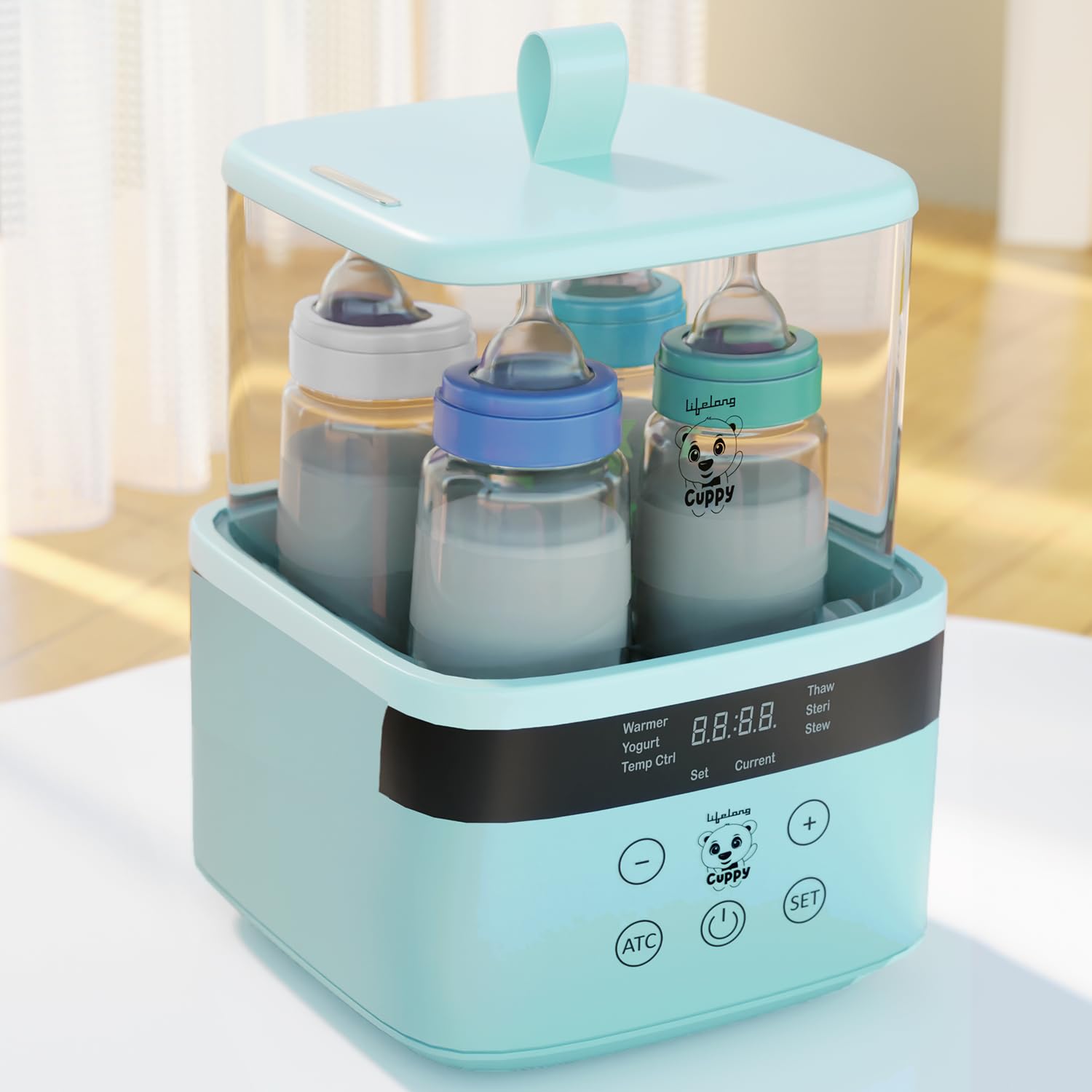In those quiet, tender moments of nighttime feedings, when the world shrinks down to the soft breathing of my child, I understand deeply the immense responsibility cradled in my arms.
As a parent, I find that safeguarding my baby’s health begins with the most fundamental of tasks—ensuring that each bottle they rely on is as pure as the love I feel for them.
This is why finding the best bottle steriliser is more than just a purchase; it’s a peace-of-mind investment, a testament to the invisible armor we wield against the unseen to protect these delicate new lives.
For every new and expecting parent scouring the market for bottle steriliser recommendations, I recall the overwhelming array of choices and the weight of decision.
It’s not just about picking a product but pledging to an ally that promises cleanliness and care with every use. My journey has taken me through countless reviews and product specifications, and I’m here to share that wisdom, offering guidance on which type of bottle steriliser is best for a variety of family needs and lifestyles.

Key Takeaways
- Understanding the crucial role of a bottle steriliser in your baby’s health
- How to navigate the sea of bottle steriliser options with confidence
- Factors to consider when seeking the best bottle steriliser for your family
- Insights into various sterilisation methods and their benefits
- Perspective on the importance of personal experiences in making the best choice
Introduction to Bottle Sterilisation
Ensuring the health and safety of infants begins with proper sterilisation of feeding equipment. The process of sterilising baby bottles is paramount, not only to prevent infections but also to promote a healthy feeding environment. This introduction will dive into the sterilization importance of baby bottles and discuss which sterilization method is most effective in eliminating harmful germs.
The Importance of Sterilising Baby Bottles
According to the Centers for Disease Control and Prevention (CDC), sterilising feeding items plays a critical role in safeguarding infants from bacteria and viruses that can cause illness. Without sterilisation, baby bottles can harbor remnants of milk and other liquids, which are breeding grounds for bacteria. The key to effective sterilization is ensuring that all parts of the bottle, especially the nipples and caps, are free from residue and thoroughly cleaned before proceeding with any method of sterilization.
Overview of Sterilisation Methods
Various sterilisation methods offer different benefits and are suitable for diverse needs. Here’s a brief overview:
- Steam Sterilisation: Utilises intense steam heat to kill bacteria and viruses efficiently.
- Boiling: Involves placing feeding items in boiling water for a set period, usually about 5 to 10 minutes.
- Microwave Sterilisation: Uses microwave-safe steriliser boxes to generate steam by heating water inside the unit.
- Cold Water Sterilisation: Involves using a sterilising solution in cold water, suitable for times when heat-based methods are impractical.
Given the variety of choices, parents may wonder which sterilization method is most effective. Studies suggest that different methods can be equally effective as long as they are performed according to manufacturer guidelines and with careful attention to detail.
| Method | Description | Effectiveness |
|---|---|---|
| Steam Sterilisation | Uses hot steam to kill germs | High |
| Boiling | Boils items in water | Moderate to High |
| Microwave Sterilisation | Uses steam created in a microwave | High |
| Cold Water Sterilisation | Utilizes sterilising solution in cold water | Moderate |
Choosing the right sterilization method depends not only on its effectiveness but also on the specific bottle steriliser features that align with your family’s lifestyle and needs. For instance, a steam steriliser might be a perfect choice for someone who values speed and efficacy, depending on their daily routine and volume of bottles to sterilize.
Which Type of Bottle Steriliser Is Best
When parents ask me, “which sterilizer is best?”, my response often hinges on a mix of personal experience and recent advancements in sterilization technology that cater to diverse family needs. Identifying which bottle sterilizer is good involves evaluating several key factors, including efficiency, convenience, and safety. In the quest to find the best sterilizer for baby bottles, it’s paramount to consider your particular lifestyle and the specific demands of your routine.
For instance, parents on the go might find portable models more suitable, while those with more room might prefer larger, more feature-rich options. Below, I’ve mapped out various scenarios to guide parents through picking the best sterilizer for baby bottles based on their specific circumstances.
- Busy urban living: High-speed sterilizers that clean quickly suit the fast-paced urban lifestyle where time is a precious commodity.
- Rural or spacious home setups: Where space isn’t an issue, larger sterilizers that can process multiple bottles and accessories at once may be ideal.
- Travel-frequent families: Compact, lightweight sterilizers that can easily fit into luggage and operate on-the-go are essential for travel.
In conclusion, the question of which sterilizer is best doesn’t have a one-size-fits-all answer. It’s about matching the right type of sterilizer to the specific needs and rhythms of your family life.
Different Types of Bottle Sterilisers Explained
In the realm of baby care, ensuring that your feeding equipment is sterile is non-negotiable. However, the choice between different types of bottle sterilisers can be daunting. In this section, I will provide an overview of the main sterilisers: steam, microwave, UV, and electric, each designed to meet specific needs and preferences.
Steam Sterilisers
Steam sterilisers operate by using steam heat to kill bacteria and germs. This method is highly effective and does not involve chemicals. Parents often ask, “which is better steam sterilizer or uv sterilizer?” Well, steam sterilisers are generally quicker and can sterilize multiple bottles at once, making them a great option for high volume use.
Microwave Sterilisers
Microwave sterilisers utilize the convenience and ubiquitous nature of microwaves. They require only water and microwave exposure to sterilize bottles effectively. They are incredibly compact and portable, which is beneficial for parents who travel or have limited space.
UV Sterilisers
UV sterilisers use ultraviolet light to disinfect, which involves no heat or steam. This method is gentle on accessories but powerful against microbes and viruses. When considering a bottle steriliser comparison, UV sterilisers are often highlighted for their dry sterilization process, which eliminates any risk of burns from hot water or steam.
Electric Sterilisers
Electric sterilisers are similar to steam models but have a standalone electric heating element to generate steam. They are highly efficient but tend to be larger and more expensive, which is a factor to consider based on your budget and kitchen space.
Choosing the right bottle steriliser involves weighing the benefits of each type against your personal circumstances and preferences. Whatever your choice, ensuring your baby’s bottles are clean and germ-free is paramount.
Top Bottle Steriliser Brands on the Market
When it comes to ensuring the health and safety of your baby, choosing the right bottle sterilizer is paramount. Among the plethora of options available, the bottle sterilizer Philips Avent and the bottle sterilizer Papablic washer stand out for their efficiency and trusted performance. Here, I delve into the specifics of these top brands, helping parents across India to make informed decisions on the best sterilizer for baby bottles India.
Philips Avent, a renowned name in baby care products, offers sterilizers designed to eliminate 99.9% of germs, protecting your baby from harmful bacteria. The Avent 3-in-1 Steam Steriliser, a versatile choice, adjusts in size to accommodate various bottle types and accessories while ensuring a fast and effective sterilization cycle.
Papablic Bottle Steriliser and Dryer
The Papablic bottle sterilizer is a fantastic all-in-one solution. Not only does it sterilize, but it also dries the bottles, saving parents time and effort. Its large interior space can hold up to eleven bottles and accessories, which is great for high-volume needs, making it one of the best choices for efficiency and capacity.
Choosing the right bottle sterilizer can greatly impact your daily routine and your baby’s health. Both Philips Avent and Papablic offer top-tier models that cater to the diverse needs of families in India. Always consider the capacity, sterilization process, and safety features when selecting a sterilizer to ensure it aligns with your family’s requirements.
Comparative Analysis: Bottle Steriliser Features
When selecting the best bottle steriliser for your family, it’s crucial to understand how different features impact your daily life. The comparison below delves into essential aspects such as size, speed, and ease of use, providing insights that draw from comprehensive bottle steriliser reviews.
Size and Capacity
One pivotal bottle steriliser feature to consider is size and capacity. Larger sterilisers are ideal for families with multiple children, as they can process several bottles and accessories at once, saving time and energy. Conversely, smaller models are perfect for parents who travel often or have limited counter space.
Speed and Efficiency
The rapid sterilisation process is another critical factor in the bottle steriliser comparison. Some advanced models can sterilize bottles in as little as six minutes, making them a superb choice for parents who need to prepare multiple feeding bottles quickly throughout the day.
Ease of Use and Maintenance
Finally, ease of use and maintenance are vital considerations as reflected in various bottle steriliser reviews. Look for features like dishwasher-safe components and descaling alerts, which simplify the cleaning process. Straightforward controls and minimal setup are key for a hassle-free user experience, especially during those busy first months.
By considering these key aspects, you can make an informed choice based on which bottle steriliser features meet your family’s specific needs, ensuring both safety and convenience in your baby’s feeding routine.
Best Bottle Steriliser for Different Needs
In today’s diverse lifestyle requirements, finding the right bottle steriliser for a specific need is crucial for parents. Whether navigating the challenges of limited counter space, heading on a family vacation, or managing a nursery full of bottles, there’s an ideal steriliser waiting to simplify your parenting routine.
Best for Travel
Compact and easy to use, the bottle steriliser microwave models are perfect for parents on the move. Lightweight and designed to fit most standard microwaves, these sterilisers make it easy to ensure your baby’s bottles are clean and sterile, no matter where you are.
Best for Small Kitchens
Fitting seamlessly into limited spaces, models like the bottle sterilisers and dryer that boast a vertical design are ideal. These units not only sterilise but also dry bottles, saving precious counter space without sacrificing performance.
Best for Multiple Bottles
For parents with multiples or those who prefer preparing in bulk, choosing a bottle steriliser nz known for its large capacity is beneficial. These sterilisers can handle several bottles at once, ensuring all your bottle sterilisation is done efficiently in one go.

Selecting the appropriate bottle steriliser not only contributes to your baby’s health by keeping feeding accessories sterile but also integrates smoothly into your daily life, providing convenience and peace of mind.
Bottle Steriliser Buying Guide
Embarking on the journey to find the perfect bottle steriliser involves more than just picking any model off the shelf. With options ranging from innovative bottle sterilizer washers at places like Kmart to various online guides, the bottle steriliser buying guide is tailored to equip you with the necessary information to make an educated choice. Understanding what features align with your family’s needs is crucial in determining the right product for you.
Before we dive into the specifics, let’s consider what generally makes a bottle steriliser a must-have. The primary function, to sterilize bottles, can be accomplished through various methods offered by different devices, each with its pros and cons. Whether you’re looking towards a compact model from bottle steriliser Kmart collections, or something more robust, each type has its unique qualities.
The first aspect to consider is size and capacity. Think about how many bottles you need to sterilize daily, as it will directly affect the type of steriliser that works best for your household. A larger family might benefit from a higher capacity model, which can handle several bottles at once, saving time and effort.
Next, evaluate the speed and efficiency of the bottle steriliser. New parents will appreciate a fast-acting bottle sterilizer washer that can quickly sterilize bottles, especially during those middle-of-the-night feedings. Features such as drying capabilities and automatic shut-off can also enhance the overall usability of the steriliser.
Additionally, ease of use and maintenance are other critical factors. Look for models that are straightforward to operate and clean. Some units come with dishwasher-safe components, making them easier to maintain over time.
- Capacity: How many bottles can it sterilize at once?
- Speed: How quickly does it sterilize?
- Maintenance: Is it easy to clean and maintain?
- Features: Does it include additional functions like drying or deodorizing?
Every family’s needs are distinctive, and your choice in a bottle steriliser should reflect those needs. Whether it’s a simple portable model from bottle steriliser Kmart or a high-tech bottle sterilizer washer, the goal is always to provide a sanitary feeding environment for your baby.
Why Sterilisation Is Crucial for Your Baby’s Health
As a parent, ensuring the health of your baby is paramount. One key aspect that can sometimes be overlooked is the sterilization importance of baby feeding equipment. Using devices like the bottle sterilizer Avent sterilizer is not just about cleanliness; it’s about safeguarding your baby’s health from harmful bacteria that can lead to serious illnesses.

Bacteria and other pathogens can thrive in milk residue left within bottles and nipples. This is where the role of an efficient bottle sterilizer steps in, eliminating 99.9% of harmful germs if used correctly. For instance, the Avent sterilizer uses steam to ensure that every nook and cranny of your baby’s bottles is sanitized, providing peace of mind about your baby’s health and safety.
The sterilization importance cannot be stressed enough, especially in the first year of your child’s life when their immune system is still developing. Medical professionals universally agree that sterilizing bottle feeding equipment is crucial in preventing gastrointestinal infections in infants, which can be severe and distressing.
Thus, investing in a reliable bottle sterilizer like the Avent sterilizer becomes an essential part of your baby care regimen. This is not just for ease but for ensuring enduring health and happiness for your little one.
User Reviews and Experiences
When selecting the optimal bottle steriliser, real-world insights and user experiences are invaluable. As someone navigating this market, I’ve delved deep into bottle steriliser reviews across various platforms to bring forward a synthesis that highlights genuine user feedback and shared experiences.
- Advantages Based on User FeedbackEfficiency in sterilization process
- Convenience for busy parents
- Variety of sizes fitting different needs
- Disadvantages Based on User FeedbackMaintenance requirements can be high
- Initial cost might be considered steep by some
Focusing on user experiences, let’s explore some collective evaluations that might help you decide which model could best meet your needs. From compact designs praised for their travel-friendliness to larger units acclaimed for their capacity to sterilize multiple bottles and accessories at once, the range is commendable.
| Feature | Common Praise | Common Complaints |
|---|---|---|
| Speed | Quick sterilization | Can vary based on model |
| Maintenance | Easy with clear instructions | Frequent descaling required |
| Design | Modern and compact | Bulky models can be an issue |
Real-world insights from these bottle steriliser reviews reveal a mixed bag of appreciations and areas for improvement. This table harnesses those details into a clear visual representation, helping you understand the balance between the pros and cons.
Now let me offer some recommendations based on broad user experiences:
- Assess your space and need for portability: If space is limited or you travel often, a compact, fast-working steriliser is key.
- Consider your daily usage: For those needing to sterilize multiple bottles frequently, opting for a larger, perhaps slightly pricier model may save time and effort in the long run.
- Read up on maintenance: Be prepared for some upkeep, and choose models praised for easy maintenance protocols.
In conclusion, by grounding your choice in the real-world insights described in these bottle steriliser reviews, you’re much more likely to find a product that not only meets but exceeds your expectations.
Conclusion
As we have explored throughout this article, the health and wellbeing of our children is paramount, making the choice of which type of bottle steriliser is best not just a matter of convenience, but of safety. From steam to UV light sterilisers, each type offers unique benefits that cater to different family needs and preferences. My goal was to provide you with informed bottle steriliser recommendations so that you can make a choice that fits seamlessly into your routine while ensuring the utmost care for your baby’s feeding implements.
When looking for the top bottle steriliser, consider not just the sterilisation method, but also the size, efficiency, and user-friendliness that will make your daily tasks a bit simpler. Our comparative analysis of leading brands such as Philips Avent and Papablic should have provided a clearer picture of what is available on the market, and what might be best suited to your home and lifestyle.
In conclusion, I hope my insights on the topic of bottle sterilisers have illuminated the significance of this vital baby care appliance. The right steriliser can bring peace of mind to parents and guardians by ensuring that their baby’s feeding items are free from bacteria and harmful pathogens. By considering the bottle steriliser recommendations and insights shared, you should now be well-equipped to choose the most effective and convenient option, thereby safeguarding your child’s health with every bottle prep.
FAQ
Why is choosing the right bottle steriliser so important?
Selecting the appropriate bottle steriliser is crucial because it ensures that feeding bottles and accessories are free from harmful bacteria and viruses, protecting your baby’s health. The right steriliser fits into your lifestyle and meets your family’s specific needs, providing convenience and peace of mind.
What are the main methods of bottle sterilisation?
The primary methods of bottle sterilisation include steam sterilisation, using either an electric steam steriliser or a microwave steam steriliser; UV sterilisation, which employs ultraviolet light to kill germs; and cold water sterilisation, which uses a sterilising solution in cold water to disinfect bottles and accessories.
Which type of bottle steriliser is the most effective?
Both steam and UV sterilisers are highly effective at killing 99.9% of harmful germs and bacteria. The choice between steam sterilisation and UV sterilisation often depends on personal preferences, the specific needs of the family, and the items being sterilised.
Are there any advantages to using a microwave steriliser over other types?
Microwave sterilisers are advantageous due to their speed and the convenience of not requiring a separate appliance. They are compact, portable, and suitable for traveling. However, their capacity may be limited compared to some electric sterilisers, and they require a microwave for operation.
Can I sterilise my baby’s bottles in a dishwasher?
Yes, many dishwashers have a sanitizing cycle that can effectively sterilise baby bottles, although it’s important to confirm that your dishwasher has this feature and to use it according to the manufacturer’s guidelines. Additionally, you should ascertain that your baby’s bottles are dishwasher-safe.
How do I choose the best bottle steriliser for traveling?
When choosing a steriliser for traveling, look for a compact and lightweight option. Microwave bags or portable UV sterilisers are commonly recommended because they are easy to pack and can be used anywhere with access to a microwave or a USB power source, respectively.
What should I consider when buying a bottle steriliser?
When purchasing a bottle steriliser, consider factors such as the size and capacity (to fit your bottles and accessories), the speed and efficiency of the sterilisation cycle, the ease of use and maintenance, portability for traveling, and compatibility with your baby’s feeding equipment.
Is it safe to use second-hand bottle sterilisers?
Using a second-hand bottle steriliser can be safe, provided it’s in good condition and has been thoroughly cleaned and descaled if necessary. Always check that it functions correctly and adhere to the manufacturer’s guidelines for use and maintenance.
Can I sterilise anything other than baby bottles in a bottle steriliser?
Yes, many bottle sterilisers are designed to accommodate a variety of baby feeding equipment, such as breast pump parts, pacifiers, teething toys, and small plastic feeding utensils, as long as they are heat-resistant and fit within the unit.
How often should bottle sterilisation be done?
It’s recommended to sterilise baby bottles and feeding accessories at least once a day, preferably after each use, especially for babies under three months old, preemies, or those with a weakened immune system. Older babies with more developed immune systems may not require as frequent sterilisation, but maintaining cleanliness is always important.




